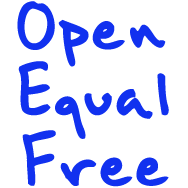 I love the open content movement. A lot. I’ve always believed that computers provide an amazing opportunity to make information and art (and therefore education) completely free.
I love the open content movement. A lot. I’ve always believed that computers provide an amazing opportunity to make information and art (and therefore education) completely free.
At first, it seemed this dream could only come about through piracy. Napster, then later services like Limewire, and even later Bittorrent, provided ways for users to share files but most of the best stuff was copyrighted and therefore illegal to share. Although everyone should want to share their amazing works, it’s their right not to, and our moral obligation to respect that, even if the creators are purely being selfish.
Then came Creative Commons licensing, and it’s turned out to be a game changer. Although many artists and infomaniacs want to keep their works under lock and key, even more are happy to share but didn’t have the legal know-how to do it while protecting their interests. Creative Commons has created a series of licenses, complete with legalese, that allow creators to make informed decisions about how much they want to share and under what circumstances.
The Creative Commons licenses are simple to pick and to apply to your works. Below you can see how easily they work, and what they mean for you.
Attribution (CC BY)
You’re just so honored that someone would like to use your work that as long as they give you credit they can do whatever they want with it. This is the most flexible license and allows people to put your work anywhere and into anything so long as they credit you as the creator. They can even adapt it as long as they give you credit in a way that doesn’t imply you endorse their changes. For example, they can say “adapted from” but not “created in partnership with.”
With this license your name could end up in magazines, books, high-profile websites… anywhere!
Attribution Share Alike (CC BY-SA)
This is the license we most recommend. Just like with the basic BY license, people can use your work or adapt it as long as they give you credit, but, SA means they also have to share what they make or use under the same license. It’s less limiting than a Non-Commercial license because it removes the worry of some ambiguous situations: Can a for-profit share your work? Can ads be on a site where your work is shared? With a BY-SA license, the answer is yes, as long as they can get and use your work under the same license.
With this license your work gets out into the world and keeps getting out, because everyone who loves it and uses it will share your work and their own additions for free, too! This license has the benefit of always increasing the pool of creative content from which people can draw.
Attribution No Derivatives (CC BY-ND)
This license allows people to use your work as is, no changes. We generally suggest avoiding this license because:
- Art: Art is a growing, beautiful, and organic thing. Artists should share and collaborate and work together for greatness. Limiting creative expression and growth just feels wrong.
- Information: Times change, contexts change, people change. By allowing others to adapt your work to fit into new situations, you’re spreading your message even further and helping the world grow that much more.
Attribution Non-Commercial (CC BY-NC)
NC is a little sticky. At first glance, it sounds great. “I don’t mind people using my work, I just don’t want them making money off it without me!” Know that you retain full ownership of your open content, even if you license it. As they say, money makes the world go round, and some monetization can help spread your works and make your contributions more meaningful. Attribution always allows interested parties to find their way to you and a free resource.
“Commercial” is actually not very well defined, and it doesn’t look like it will be any time soon. Lack of definition in effect means lack of effectiveness: If there’s no clear definition, there are no clear restrictions.
So, unless you hate the idea of a banner ad on the same page as your photos, steer clear of the Non-Commercial restriction.
Attribution Non-Commercial Share Alike (CC BY-NC-SA)
This is slightly better, as it means your work will always be shared wherever it shows up, but it’s still not our cup of tea. But, can you think of a situation where they share your work under the same license you did (SA) that would make you upset?
If a social enterprise is fighting for education equality by selling education kits to schools in the U.S. and donating one-for-one to the developing world, do you really not want your pictures on their website or slideshows?
It’s a personal call, but we definitely have an opinion.
Attribution Non-Commercial No Derivatives (CC BY-NC-ND)
If you have made the perfect work of art (or written the perfect article) that you only want to show in its original, pure form on non-profit websites without any monetization whatsoever, this is the license for you, Mr. or Mrs. Grumpster.
See the rest of our Free Media Guide for more info on how to license, find, and make the best open content!
Creative Commons Love: Creativesam and Extranoise on Flickr.com
Written by Michael Jones


